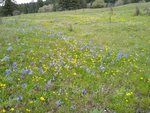

Thurston County has a rare habitat type that is underappreciated – prairies. These are native grasslands that, 200 years ago, stretched for scores of miles in the relatively flat central and south part of the county, including parts of Joint Base Lewis McChord (JBLM). These prairies are a gift of the continental glacier that visited the area 10,000+ years ago, leaving behind vast tracts of sand and gravel as it retreated.
Eventually, soil accumulated after the glacial retreat, but this soil is often poor and relatively shallow. And, because of the gravel, much of the rainfall hitting these prairies percolate directly underground. Poor soil and little water led to unique plant and animal communities and, not surprisingly, some bird species well adapted to these grasslands.
Last weekend Liam and I visited one of the county’s prairies, checking on the wildflower bloom and hoping to photograph some of the birds there. We had good success, as you can see from our photographs.
Perhaps the most common birds on the prairies are native sparrows. The most common of these is the Savannah Sparrow. These are small and have a streaked light brown appearance. They will fly in front of you, jumping up from the ground where they were feeding. (They also nest on the ground but probably are not nesting yet). They also fly “lightly,” seemingly to flit around. And I love their common name. Although we call our open grasslands prairies, these south county habitats are really our savannahs.
A second sparrow, again fairly common, is the Chipping Sparrow This is a larger bird with a prominent brick-red cap, a white eyebrow, and a black stripe through its eye. Its song is a long single-note trill, probably the only such trill you will hear out on the prairies. A third common sparrow is the White-crowned Sparrow, described in last week’s column.
Another bird out on the prairies is special to me, the Western Bluebird. That’s because for about 20 years I maintained a bluebird box trail on JBLM. Next week’s column will focus exclusively on what I learned over those years.
While the sparrows feed primarily on the vegetation, the bluebirds are insect hunters. They sit patiently on a perch, then quickly fly off in pursuit of an insect they have spotted.
We saw another interesting and somewhat unexpected bird insect-catching: the Yellow-rumped Warbler, a bird whose name tells you one good way to identify it. These birds nest up in fir trees on the prairie edges, but they venture out on the grassland for feeding.
Prairie Appreciation Day
Each year in our county we have a Prairie Appreciation Day. This year it’s Saturday, May 14. Additional information and directions to several publicly owned prairie areas is at http://www.prairieappreciationday.org/. These are great natural areas, and we are fortunate that government officials have acted to preserve them.
Some of these prairies exhibit the unique Mima Mounds, a special geologic feature of our county. They all are well worth a visit, and especially during the spring wildflower bloom. But you might not want to wait until the 14th. Liam and I found that wildflowers are already in full bloom, but we didn’t see any of the interesting prairie butterflies. Maybe they will be out and about by May 14.
Here are a few other birds that also are found on the prairies:
You might also see a soaring Red-tailed Hawk, or the smaller American Kestrel, which can hover like a helicopter.
And one last bird-finding suggestion – since water is rare on the prairies, birds often gather around the odd lingering mud puddle. Find that puddle and you’ll likely find birds.
George Walter is the environmental program manager at the Nisqually Indian Tribe’s natural resources department; he also has a 40+ year interest in bird watching. He may be reached at george@theJOLTnews.com
Photos for this column are provided by Liam Hutcheson, a 14-year-old Olympia area birder and avid photographer.
2 comments on this item Please log in to comment by clicking here
Drutty
Thank you for this delightful article and the hope to visit Mima Mounds.
Thursday, May 5, 2022 Report this
Annierae
Great information, thank you. Too bad we missed you on May Day, when we noticed the shooting stars were mostly done for the season.
Thursday, May 5, 2022 Report this